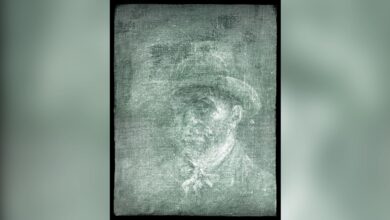
The “RGB” exhibition at the Townhouse gallery is a dark horse.
I must admit that I didn’t get it at first; I had become lazy, and I almost chose to agree with my equally lazy friends about this show. But RGB is one of those rare moments where you get to witness something more evolved. This is art-production at its finest, an experiment and a risk. It can be exasperating and amusing, and is at some moments over your head.
The set-up is simple: the gallery is left very bare. A projection fills one wall. On the day that I visited, the projection was of a woman working at her desk in an unremarkable and disheveled office most likely on one of the winding streets of downtown Cairo. After reading the convoluted preamble on a tired day, words like “additive,” “trichotomy” and “interplay” offended my dulled faculties. I stared at this woman for a couple of minutes and then gave up. This was a shame.
The truth is that "RGB" is one of the first shows in a while that is trying to engage its audience in a more cognitive way by investigating a series of abstract and philosophical questions: Who is the artist, who is the audience, and how do they encounter each other in those hallowed halls of the gallery space?
If “RGB” were an experiment, the controlled variable would be the set up. A camera is placed on a tripod in the artist’s studio that projects into the gallery space of the Townhouse. The artist also gets to see what happens at the gallery. However, any audio between these spaces is muted, so the two worlds stand next to each other, fully aware of the other but without any real sense of communication.
“It is an experiment. Something you can plan only in the set up. We tried to do something really simple and allow space for that to occur… In the most basic sense [‘RGB’] is based on the idea of classical studio visits,” says the show’s curator Alexandra Stock. “Back in the springtime I was conducting these visits for curators. It occurred to me that people didn’t have the chance to see artists in their space, or even their work in an earlier stage of production. It’s a very intimate realm. And I find it interesting to connect the artist and their space with the audience because it’s a stage [of production] not normally seen.”
So we watch a number of local artists in their domiciles, hovels and studios “working,” or whatever we have come to expect “work” and the artistic process to be.
The artistic process has been forever shrouded in mystery; the work of an artist is considered to involve the unseen hand of the muses, the throwing together of splotches of paint, and handfuls of sequins, and detritus from our organized lives. It is just “created,” and expected to exist in its final form already, a preconceived notion. But as any artist could attest, the artistic process is work like any other. It involves time and wasted efforts. Sometimes it even involves sitting at a desk and drinking coffee like anyone else.
For artist Taha Belal, it involved sleeping in his boxers for the entire day. Much of the screening was taken up by a giant image of the crown of his head as he slept. And this act in itself is brilliant for the multiplicity of meanings it inspires. Firstly, Belal pays lip service to the stereotype of the idle and drunken artist that sleeps all day, magically churning out masterpieces comprehensible only to those that write volumes about splotches on canvases and deign them to be genius. Additionally, Belal reframes the notion of “work,” having had to stay up during the night to prepare to sleep during the show. The artist had to exert a conscious effort to act this kind of work. And thirdly, we get to watch the ultimate tedium of the working life, something that is further emphasized in its contrast to the professionalized gallery space, a space which by the sanctum of its walls, suggests something that should be appreciated by virtue of its presence within said space.
“It’s interesting to collapse spaces of exhibition and production. It’s a mundane, simple idea: what it means and looks like to be an artist. On the opening night, young people were really confused,” Stock says.
The artist Yasmina Metwaly was being filmed. Why was she conducting interviews? was the question on the viewers’ minds, she explains. They didn’t want to believe that these were artist’s studios. They were thrown off base. The whole idea of the “artist” confers a notion of skills and arts.
“People didn’t want to believe. They wanted physical evidence of the creative act through specific media.”
“RGB” was a confrontation between the audience’s expectations and the three different bodies that assert and ascribe meaning to a work – the viewer, the artist, and the gallery.
And it is this interplay that makes “RGB” so successful. The trinity of elements is reflected in the show’s title, referring to the single element the three things have in common: the light spectrum that makes each element visible to the human eye. Through this chance meeting of realms and media we discover most clearly that the act of creation is a complete accident. It is a confluence of a number of facilities, spaces and appreciations, just like the show. It is chance, circumstance and confusion, and according to Stock, “the confusion was exhilarant.”
“RGB” exhibition is open at the Townhouse Gallery until 5 November.




